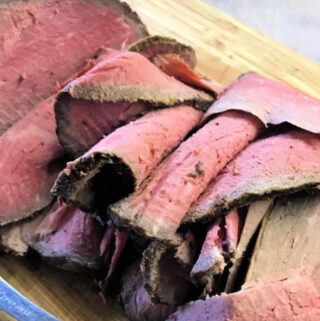
How to Cook Eye of Round Roast Beef
Eye of round, a simple boneless beef roast, is what’s called a “whole muscle” cut of beef. It’s one of the best cuts for sandwiches with gravy or for making Beef Wellington….and leftovers, too. Whether you’re cooking eye of round with a slow cooker, InstaPot (Instant Pot), or your oven, this roast is delicious.
Servings: 8 servings
Chef Alli
Save this Recipe
Ingredients
Ingredients for the Roast
- 1 Tbs. Olive oil may substitute vegetable or canola oil
- 1 tsp. Kosher salt
- 1 tsp. Granulated garlic
- Freshly ground black pepper to taste
- 1 Eye of round roast, 3 lbs.
Ingredients for the Pan Sauce
- pan drippings from cooking the roast
- 2 Tbs. red wine, such as cabernet or merlot
- 1 cup beef broth
- 2 Tbs. unsalted butter softened
- 2 Tbs. all purpose flour
Instructions
Prepare the Roast the Night Before
- Slather the roast with the olive oil on all sides, then season the roast with the salt, garlic, and black pepper. Place the roast into a large freezer bag; seal the bag and place it into a bowl in the fridge.
Make the Roast
- 1-2 hours before you want to cook the eye of round roast, remove it from the plastic bag and let it rest on the counter, uncovered. This will let the roast rest and also removes the chill from the meat so it can cook much move evenly.
- Preheat the oven to 450 degrees F. Place the prepared roast into a greased 12-inch cast iron skillet or roasting pan, then into the oven on the center rack. Roast the meat, uncovered, for 20-25 minutes or until very nicely browned all over the top and bottom.
- Reduce the oven temperature to 325 degrees F.; continue to cook the roast, uncovered, for 45-60 minutes, just until it reaches 125 degrees F. at the center of the roast. Begin testing the internal temperature of the roast at about the 40 minute mark to be sure you don't overcook the roast - this is very important.
- When the roast reaches the internal temperature of 120-125 degrees F. at the center, remove it from the oven, placing it onto a large cutting board. Cover the roast well with foil; let the roast rest for 20-30 minutes.
Make the Pan Sauce
- While the roast rests, make the pan sauce. Over medium heat, add the wine to the drippings in the skillet or roasting pan; use a whisk to remove any of the attached bits of fond that are stuck to the bottom of the skillet. Continue whisking until the wine is nearly evaporated, then stir in the broth and heat until simmering.
- In a small bowl, combine the butter with the flour to form a paste, then add to the simmering broth, cooking over medium low for 8-10 minutes or until nicely thickened; season the sauce to taste with salt and pepper.
Serve the Eye of Round Roast
- Using a sharp carving knife, cut the roast into slices, across the grain. Place the slices onto plates; drizzle with the pan sauce, as desired.
Notes
- When cooking any roast (beef or pork, either one) always be sure to let it rest on the counter, unwrapped, for at least an hour or so. This removes the chill from the meat and lets it relax so it can cook much more evenly, no matter what the cooking source will be….oven, stove top, grill, or smoker.
- Never overcook eye of round roast, if at all possible! Because this is such a very lean cut of beef, it can easily overcook if you don’t keep a careful watch with your instant-read meat thermometer.
- Over cooking eye of round roast will seal it’s fate: it will be nearly flavorless, dry, and chewy. Don’t go there!
- Never cook an eye of round roast without using a meat thermometer of some kind. The use of a meat thermometer will keep from overcooking the roast, this is very important.
- Before slicing an eye of round roast, be sure to let it rest, covered, when you remove it from the oven. This resting period is very important for letting the protein fibers relax and to allow the beef juices to integrate back into the center of the roast.
- Always be sure to slice any meat (beef, pork, venison, bison…whatever) across the grain. Slicing meat against the grain (instead of with the grain) cuts the protein fibers into shorter pieces, helping the meat be tender and easy to chew.
- The reason you don’t want to cut a roast or any hunk of meat with the grain (or along it) leaves the protein fibers in long lengths which can make meat tough and hard to chew….often compared to shoe leather.
Nutrition
Calories: 254kcalCarbohydrates: 2gProtein: 33gFat: 12gSaturated Fat: 5gCholesterol: 102mgSodium: 459mgPotassium: 507mgFiber: 1gSugar: 1gVitamin A: 87IUCalcium: 24mgIron: 3mg
Tried this recipe?Let us know how it was!